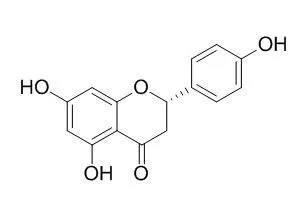| Animal Research: |
| Prog Neuropsychopharmacol Biol Psychiatry. 2010 Oct 1;34(7):1223-8. | | Involvement of monoaminergic system in the antidepressant-like effect of the flavonoid naringenin in mice.[Pubmed: 20603175 ] | Dietary flavonoids possess a multiplicity of neuroprotective actions in various central nervous pathophysiological conditions including depression.
METHODS AND RESULTS:
In this study, the neuropharmacological mechanism of the dietary flavonoid Naringenin was investigated in the mouse behavioral models of depression. For this purpose, we investigated the influence of pretreatment with the inhibitors of serotonin or noradrenaline synthesis, p-chlorophenylalanine methyl ester or α-methyl-p-tyrosine, respectively in the anti-immobility effect of Naringenin. Compared to the control group, Naringenin significantly decreased the immobility time after acute treatment in the mouse tail suspension test (10, 20 and 50 mg/kg), but not in the forced swimming test, without producing locomotor alteration in the open-field test. In addition, pretreatment of mice with p-chlorophenylalanine methyl ester (100 mg/kg) or α-methyl-p-tyrosine (100 mg/kg) prevented the anti-immobility effect of Naringenin (20 mg/kg) in the tail suspension test.
CONCLUSIONS:
Taken together, this data demonstrated that Naringenin possessed potent antidepressant-like property via the central serotonergic and noradrenergic systems. Thus, our findings suggest the therapeutic potential of this dietary flavonoid in central nervous system disorders especially depression where monoaminergic systems are involved. | | Biochem Pharmacol. 1995 Oct 26;50(9):1485-93. | | Naringenin: a weakly estrogenic bioflavonoid that exhibits antiestrogenic activity.[Pubmed: 7503800] |
METHODS AND RESULTS:
Treatment of immature 21-day-old female Sprague-Dawley rats with 17 beta-estradiol (E2) (0.5 microgram/rat) caused a significant increase in uterine wet weight, DNA synthesis, progesterone receptor (PR) binding, and peroxidase activity.
At doses as high as 40 mg/rat, the bioflavonoid Naringenin did not cause a significant increase in any of these E2-induced responses. However, in rats cotreated with E2 (0.5 microgram/rat) plus Naringenin (30 mg/rat); there was a significant decrease in E2-induced uterine wet weight, DNA synthesis, PR binding, and peroxidase activity, indicating that Naringenin exhibits antiestrogenic activity in the immature rodent uterus. The binding of uterine nuclear extracts to a 32P-labeled estrogen responsive element (ERE) or progesterone responsive element (PRE) was determined using gel electrophoretic band shift assays. Incubation of [32P]ERE with uterine nuclear extracts from rats treated with Naringenin or E2 resulted in the formation of estrogen receptor (ER):ERE complexes; a higher mobility complex was prominent in the extracts from E2-treated rats, whereas a lower mobility complex was observed using nuclear extracts from Naringenin-treated animals. There was a significant decrease in the intensity of the E2-induced complex using nuclear extracts from rats treated with E2 plus Naringenin. In contrast, transformed cytosol from control rats gave an intense ER:ERE complex, whereas the intensity of the band was decreased markedly using transformed uterine cytosol from treated rats. Formation of a PR:PRE complex was also determined using transformed uterine cytosol. Cytosol from E2-treated rats gave an intense retarded band, whereas only weak bands were observed using cytosols from DMSO- (solvent), Naringenin-, or Naringenin plus E2-treated cells. The results of in vitro studies showed that 1 nM E2 increased (3- to 4-fold) the growth of MCF-7 human breast cancer cells, whereas 1-1000 nM Naringenin had no effect on cell proliferation. In cells cotreated with 1 nM E2 plus 1000 nM Naringenin, there was a significant decrease in E2-induced cell growth. In MCF-7 cells transiently transfected with a pS2 promoter-regulated luciferase reporter gene, Naringenin exhibited weak estrogenic activity. In cells cotreated with 0.1 or 1.0 microM Naringenin plus 1 nM E2, Naringenin inhibited E2-induced luciferase activity.
CONCLUSIONS:
The results of these studies confirmed that Naringenin is a weak estrogen that also exhibits partial antiestrogenic activity in the female rat uterus and MCF-7 human breast cancer cells. | | Biochem Biophys Res Commun. 2001 Jun 15;284(3):681-8. | | Anti-atherogenic effect of citrus flavonoids, naringin and naringenin, associated with hepatic ACAT and aortic VCAM-1 and MCP-1 in high cholesterol-fed rabbits.[Pubmed: 11396955] | The anti-atherogenic effects of the citrus flavonoids, naringin and Naringenin, were evaluated in high cholesterol-fed rabbits.
METHODS AND RESULTS:
At 3 months of age, 30 male New Zealand White (NZW) rabbits were divided into three groups (n = 10 per group). The rabbits were fed a 1% cholesterol diet alone (control group) or a diet supplemented with either 0.1% naringin or 0.05% Naringenin for 8 weeks. The plasma lipoprotein levels, total cholesterol, triglyceride, and high-density lipoprotein showed no significant differences in the control and experimental groups. Hepatic acyl-CoA:cholesterol acyltransferase (ACAT) activity was slightly low in naringin (5.0%)- and Naringenin (15.0%)-fed rabbits, compared to control group. The aortic fatty streak areas were significantly lower in both the naringin (19.2 +/- 5.6%)- and Naringenin (18.1 +/- 6.5%)-supplemented groups than in the control group (60.4 +/- 14.0%). The expression levels of vascular cell adhesion molecule-1 (VCAM-1) and monocyte chemotactic protein-1 (MCP-1), by semiquantitative RT-PCR analysis of the thoracic aorta, were significantly lower in the flavonoids supplemented groups than in the control group.
CONCLUSIONS:
These results suggest that the anti-atherogenic effect of the citrus flavonoids, naringin and Naringenin, is involved with a decreased hepatic ACAT activity and with the downregulation of VCAM-1 and MCP-1 gene expression.
|
|






 Cell. 2018 Jan 11;172(1-2):249-261.e12. doi: 10.1016/j.cell.2017.12.019.IF=36.216(2019)
Cell. 2018 Jan 11;172(1-2):249-261.e12. doi: 10.1016/j.cell.2017.12.019.IF=36.216(2019) Cell Metab. 2020 Mar 3;31(3):534-548.e5. doi: 10.1016/j.cmet.2020.01.002.IF=22.415(2019)
Cell Metab. 2020 Mar 3;31(3):534-548.e5. doi: 10.1016/j.cmet.2020.01.002.IF=22.415(2019) Mol Cell. 2017 Nov 16;68(4):673-685.e6. doi: 10.1016/j.molcel.2017.10.022.IF=14.548(2019)
Mol Cell. 2017 Nov 16;68(4):673-685.e6. doi: 10.1016/j.molcel.2017.10.022.IF=14.548(2019)